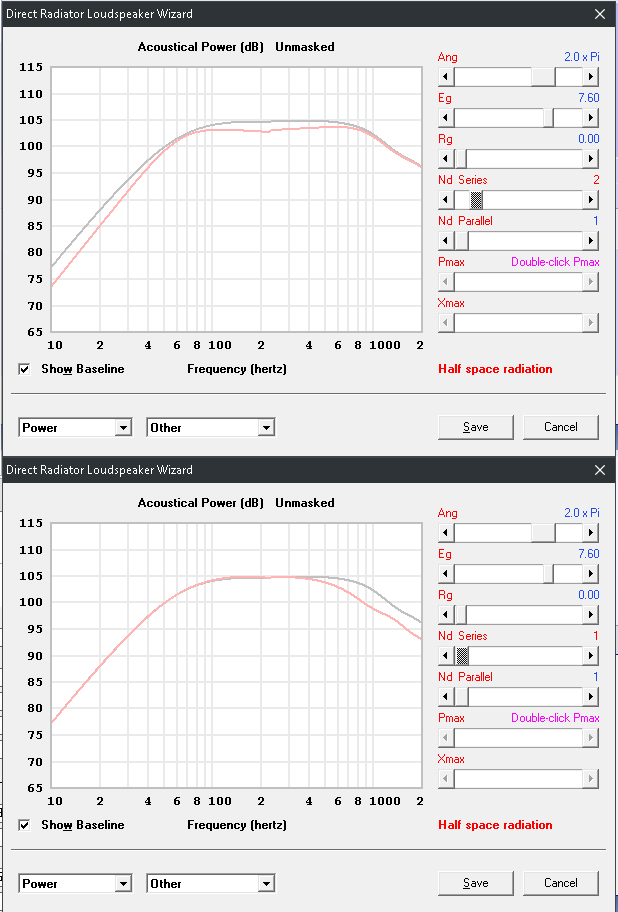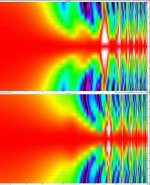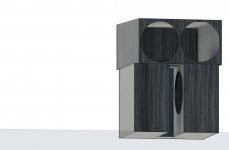2 in series should dbl inductance and thus lower Hf sensitivity youd think
No I do definitley not think that ! And I bet many others don't think that either. I let you guess why this is the case before giving you the reason.
But HF response wouldn't improve either. And one has to be careful when using two drivers for the same frequency range when it comes to the reproduction of short wavelengths due to lobing.
Regards
Charles
Two drivers in series, dbls Le. How this affects Hf performance...not sure, I just go off of what I can see in HornResp. Higher Le gets, Hf sensitivity lowers. If I dbl woofers in series Hf doesn't really change...
HornResp has a glitch, in editor, where you may get different responses when you should not.
In the pic, the lower box, notice how driver count is one but the response never goes back to the grey line.

HornResp has a glitch, in editor, where you may get different responses when you should not.
In the pic, the lower box, notice how driver count is one but the response never goes back to the grey line.
Attachments
Last edited:
Bravo! Because Re does also double the pole frequency caused by this RL circuit stays the same. SPL does generally drop by 3 dB compared to a single driver.
Regards
Charöes
Regards
Charöes
This is what I was hoping it would do....I looked at the thiele specs to see any formulas tied to le. I found non. Thank you for clarifying that!
Pole frequency, thats a new one.
Pole frequency, thats a new one.
SO even le is apart of this system where if you change one thing it changes another? Not literally...Im not saying that right just yet but...I can fix the affects of Le with a filter as well?
Last edited:
I looked at the thiele specs
A much more complete set of T/S theory and in retrospect, one of us should probably have just posted it every time you needed clarification 😉: From Keele, pg 3[2], 9[8]:
http://www.xlrtechs.com/dbkeele.com...Preprint) - LF Horn Design Using TS Paras.pdf
fHVC upper rolloff corner (-3 dB) frequency due to the effects of driver voice coil inductance acting alone
Fhvc [mH] = Re/[pi*[Le*1000]]
Breakup is minimum phase for the most part and can be corrected with EQ. Very sharp spikes can be hard to match with EQ and generally vary slightly between drivers making a real world "fix" impractical.
You are getting lots of things mixed up.
The Q of the driver and the Q of the final system are different things. The driver Q is fixed (except that it can be raised with a series resistor, but one does not generally want to do that because it wastes power. The final system Q can be manipulated with and electronic filter as has been shown here many times.
Q, damping, decay, are all the same thing just in different language. Damping usually refers to mechanical resistance and EEs prefer to use the synonymous term Q. Decay is just the view of damping in the time domain. They all track one another. Since these terms are all defined for only a linear system, they are all evident in the impulse response, just as ALL linear variables are.
As to the two tones, let's let them both be turned off at the same time, they will decay. The rate of decay will depend on the frequency response at each of those frequencies. We can make the decays the same, or not, by changing the FR at each of the tones. Hence "EQ" can and does change the decay times of these tones.
I'm getting there. I can say that it is likely better that I focus on keeping excursion down rather than Thiele specs. Some how a formula of specs that generate the least amount of heat per excursion is a likely goal...placing sensitivity where needed seems like the obvious solution?
Also, placing mechanical filters in desired place eliminates the use/need of another electrical filter to correct.
Do you guys think I could pull off twin side by side midwoofers?
I mocked up the horizontal polar at 1 meter in Vituix. If the ~36" wide elliptical tractrix horn ever works out, along with the potential success of a 300-400hz xo...higher directivity from mids would improve clarity aside from the benefits of more Sd and powerhandling.
Attachments
Last edited:
I guess I meant electro-mechanical?....or maybe the driver can be looked at like a mechanical filter?....not sure.
Last edited:
What is mechanical filter for you? I have not heard this before
As I understand it, they're quite common to this day assuming my way of viewing it is any mechanical junction that causes an impedance mismatch sufficient to cause an audible difference qualifies.
TTBOMK then, this driver is the original with two mechanical XOs to make it a three way; notice it's a single molded diaphragm with flex rings to decouple/separate them acoustically: 755A Speaker Cone — Western Electric - Maker of electron tubes and high fidelity
Drivers with whizzers, dust caps or phase plugs are mechanical three way XOs and in certain cases just the diaphragm/dust cap junction can make a two way [alum. dust cap MI drivers, etc.]
Do you guys think I could pull off twin side by side midwoofers?
Sure! Though at your seeming level of desired excellence that rivals the best W.E. could come up with, then IIRC you'll need a ~8 ft square horn termination/mouth [W.E. 15A horn] tuned to ~50 Hz.
Camplo said the cutout is for the countersunk woofer, which would be approximately flush with the cabinet face.
After a short period struggling using a pair of side by side 15" with a JBL 2385/2445 above, we cut the 11 stage monitors made in that configuration down to single 15". Need for EQ dropped considerably, and the horrible off-axis horizontal response was eliminated. Lesson learned.
A pair of 15" is also overkill, considering the 15" is only keeping up with a pair of sealed 18" used for low frequencies.
After a short period struggling using a pair of side by side 15" with a JBL 2385/2445 above, we cut the 11 stage monitors made in that configuration down to single 15". Need for EQ dropped considerably, and the horrible off-axis horizontal response was eliminated. Lesson learned.
A pair of 15" is also overkill, considering the 15" is only keeping up with a pair of sealed 18" used for low frequencies.
Okay, maybe it’s me not getting it because the way I understand it, you have the mounting flange which is part of the driver basket and you can either mount from behind or on the baffle. The thin slice of baffle between the two drivers looks too thin dimensionally to be of use.
- Yeah this, is the diameter of the holes you see...there should be another panel directly behind this to mount the drivers to.mounting flange which is part of the driver basket and you can either mount from behind or on the baffle
Camplo said the cutout is for the countersunk woofer, which would be approximately flush with the cabinet face.
After a short period struggling using a pair of side by side 15" with a JBL 2385/2445 above, we cut the 11 stage monitors made in that configuration down to single 15". Need for EQ dropped considerably, and the horrible off-axis horizontal response was eliminated. Lesson learned.
A pair of 15" is also overkill, considering the 15" is only keeping up with a pair of sealed 18" used for low frequencies.
Where did you cross it at? If I cross at 300hz, thats only 100hz away from optimal ctc spacing 200hz.
- Home
- Loudspeakers
- Multi-Way
- Is it possible to cover the whole spectrum, high SPL, low distortion with a 2-way?


